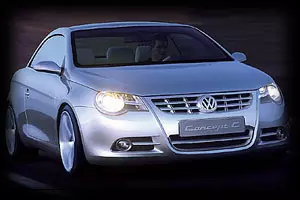Volkswagen analyzes numbers and in conclusion generates prototypes.
 According to the German giant, during 2003 in Europe, convertibles surpassed in sales to the coupe. Convertible models sold 337,000 units against only 240,000 coupes. But the fact that can make a difference in the balance is this: many of these convertibles are reformed coupes, that is, they were not born convertible.
According to the German giant, during 2003 in Europe, convertibles surpassed in sales to the coupe. Convertible models sold 337,000 units against only 240,000 coupes. But the fact that can make a difference in the balance is this: many of these convertibles are reformed coupes, that is, they were not born convertible.
The difference is that the car designed to be convertible has special considerations due to the higher demands that the chassis supports. These conditions are achieved more efficiently, as modified cars such as Volkswagen Golf or Peugeot 206 always sacrifice at some point, such as comfort or performance.
This is why Volkswagen then presented the Concept C, with a new platform that integrates elements present in the Golf and other experimental elements for the new Passat. It is a foldable hardroof convertible that houses four passengers, just as its competitor does the Peugeot 307 CC, with differences in size and design details on the folding roof. Concept C is larger in length, width and height.
It features a 4-cylinder transverse front engine in line, 2,000 cm3, direct electronic injection and 150 horsepower. It is front-wheel drive and the rear wheels are slightly larger than the front ones. The front wheels fit 235/35 on 19-inch wheels while the rear ones are 245/35 on 20-inch wheels.
While it presents some aesthetic features of the previous VW Concept R prototype, such as the front optics, there are important differences such as the four airbags and greater separation between the driver's head and the windshield frame. It also has a roll protection arch.
The folding roof is made of steel and has 5 main pieces that strip the Concept C in 9 seconds. And the way to do it is quite unique. The rear brackets and the rear window place them above the glass ceiling and then all this “package” is stored (also automatically) in the trunk. When the roof is stored, the trunk has reduced its capacity by half, from 400 dm3 to 200 dm3.
Aesthetically it is a very neat car, refined with a sporty look but elegant at the same time. In some details it was a precursor to the design of some features of the most modern Audi. It has a side line that defines relief differences extending from the top point of the front wheel arch to the rear lights. This generates an idea that the side line of the car rises more abruptly than it actually does.
© Adrián Blanco 2005 — Prohibited the total or partial reproduction of text and/or images without explicit written consent of the author. —